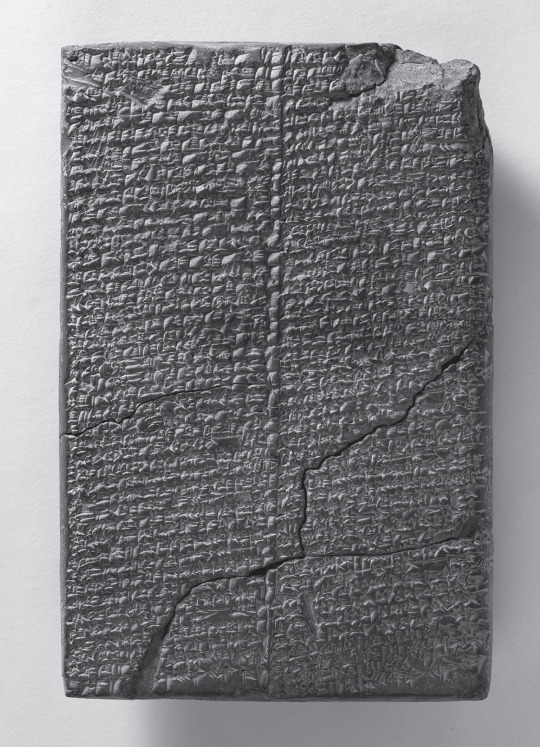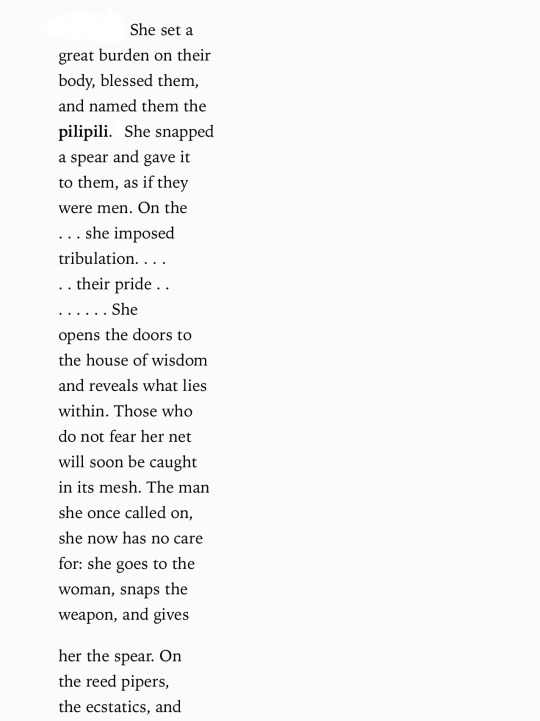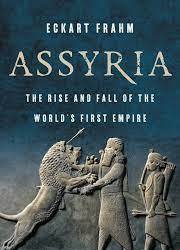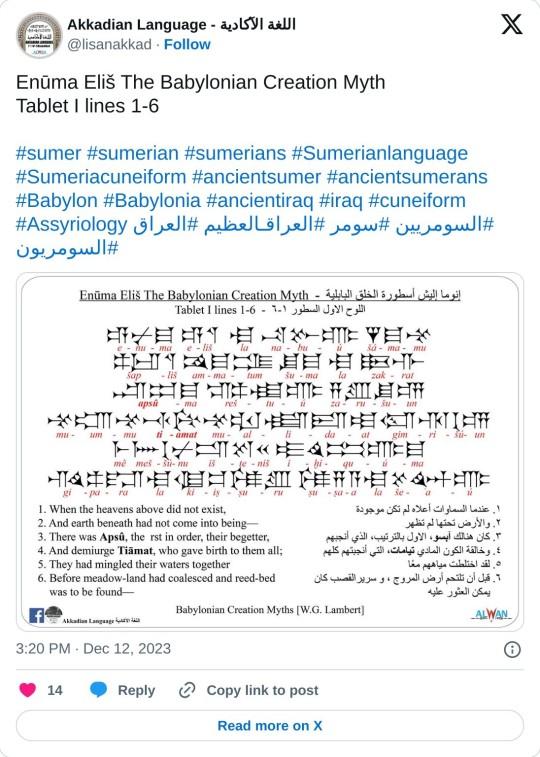#assyriology
Text
I really need to know if there’s an epic of Gilgamesh fandom on here. Gilgamesh fans please follow me I need EOG mutuals

151 notes
·
View notes
Text


The Epic of Gilgamesh
959 notes
·
View notes
Text



—Enheduana, from “The Hymn to Inana”
Gender-bending in the world’s most ancient authored text, newly translated by Sophus Helle.
From an essay by the translator: “The evidence for activities that sought to actively subvert established gender norms is much clearer when we turn to another and much more motley class of ritual performers. These included the kurĝara, the saĝ-ursaĝ, and the pilipili, as well as several other groups who were associated with the worship of Inana and who performed rituals in which they upended the usual conventions of gender. Ancient texts describe processions in honor of Inana in which the participants would wear female clothes on one side of their body and male clothes on the other. They would brandish weapons, which were the traditional signs of masculinity, as well as weaving instruments, such as spindles and distaffs, the traditional signs of femininity. By mixing and juxtaposing the standard symbols of gender, they would introduce an element of confusion and capriciousness into the conventions of gendered behavior: if the same person could wear both female and male clothes, viewers were led to ponder the nature of gender itself. It is highly likely that the various groups, such as the kurĝara and the saĝ-ursaĝ, would subvert gender norms in different ways: some were perhaps individuals who generally appeared to be female but performed stereotypically male actions, others the reverse, but because of the limitations of our sources, it is difficult to reconstruct the differences between them. Either way, these groups were all engaged in a playful scrambling of what was thought to be typically male and typically female.”
On the pilipili: “Inana then blessed them, named them, and gave them a snapped spear ‘as if they were a man’ (ll. 80–81). The passage implies that they were generally seen as women and that they announced their distance from normative gender by carrying a broken emblem of maleness. However, the text identifies them not with one gender or the other but with the transition between genders, referring to them as ‘the changed pilipili’ (l. 88). Together with the reed pipers, the kurĝara, the saĝ-ursaĝ, and the ecstatics, they are depicted as ritual lamenters: Inana ‘makes them weep and wail for her,’ so that they ‘exhaust themselves with tears and tears’ (ll. 87, 90).”

#literature#poetry#Inana#inanna#Enheduana#assyriology#Sophus helle#enheduanna#genderqueer#nonbinary#gender nonconforming#Sumerian literature
129 notes
·
View notes
Text
Realizing that he must die,
Gilgamesh grieved for all humanity,
To which the gods replied:
'You must have been told that this is what it means to be human.
You must have been told that this is what it means to have your umbilical cord cut.
The darkest day of humanity awaits you now.
The loneliest place of humanity awaits you now.'
- The Death of Gilgamesh , lines 143-153
#gilgamesh#enkidu#ancient history#grief#cycle#mesopotamia#ANE#poetry#epic poetry#ancient greece#classics#assyriology#sumerian#akkadian
46 notes
·
View notes
Text
IF YOURE 15-19 AND INTO ANCIENT HISTORY AND DEAD LANGUAGES PLEASE BE MY FRIEND DMS ARE OPEN I NEED TO TALK ABOUT THE INDUS SCRIPT
#betty grof kin#bettyposting#betty grof#ancient history#ancient egypt#ancient art#ancient mesopotamia#assyriology#cuneiform
5 notes
·
View notes
Text
Unearthing Ancient Civilizations
The Importance of Over 30,000 Preserved Cuneiform Writings
Deciphering a Lost Language
Insights into Daily Life and Culture
The Epic of Gilgamesh
Technological and Scientific Advances
Religious and Mythological Texts
The Role of Cuneiform in Modern Research
Challenges in Preservation and Interpretation
Enhancing Accessibility and Understanding
Book Recommendations
Online Resources and…

View On WordPress
#Assyriology#Babylonian mathematics#British Museum#Code of Hammurabi#Cuneiform#Cuneiform Digital Library Initiative (CDLI)#Epic of Gilgamesh#Henry Rawlinson#Louvre Museum#Mesopotamia#Mesopotamian mythology#Sumerians
6 notes
·
View notes
Text
𒁾𒁇𒊏𒀝𒁴
𒁹𒁀𒇷𒎙𒄿𒍠𒃼𒋃𒉘𒊭𒌋𒅗𒁾𒀭𒀝𒌝𒈠𒅅𒉈
𒁹 𒄀𒌈 𒆪𒌦𒉡𒌈𒊭𒌓𒁲𒆪𒌦𒈝
𒈫 𒊭𒅋𒇺𒅖𒌅𒊭𒊭𒊭𒀊𒆷𒎙𒅇𒊭𒊭𒀊𒆷𒎙𒅖𒌅𒊭𒅋𒇺𒋰𒊏𒀀𒌅𒅖𒋼𒉏𒅁𒁍𒍑
𒐈 𒆠𒈠𒄢𒆷𒌈𒅖𒌅𒅖𒋼𒉏
𒐂 𒀜𒁕𒉌𒀭𒌓𒌋𒂼𒉌𒀭𒌍
𒐊 𒂵𒂵𒀸𒅔𒃼𒋛𒋗𒅖𒋛𒄿𒎗𒅁𒌈𒅔𒃼𒋛𒊭𒄿𒁁𒅕
𒑁 𒆠𒈠𒂵𒂵𒉘𒅔𒊭𒌉𒆸𒂊𒁉𒅕𒅔𒂊𒈬𒊌𒂊𒈬𒄄
𒑂 𒅍𒀀𒈾𒀭𒎌𒅖𒌅𒆠𒁴𒌋𒀀𒈾𒊬𒆧𒁴𒊭𒊭𒀊𒆷𒎙𒅇𒅋𒇺𒄿𒉿
#akkadian#ancient languages#babylonian#cuneiform#mesopotamia#semitic languages#assyriology#ancient#emerald tablet#hermeticism#hermetica
18 notes
·
View notes
Text

Rassam Cylinder, a ten-sided clay cylinder that was created in c. 643 BC, during the reign of King Ashurbanipal (c. 685 BC - 631 BC) who ruled the Neo-Assyrian Empire from 669 - 631 BC.
It was discovered in the ancient Assyrian city of Nineveh, near Mosul, present-day Iraq, by Hormuzd Rassam (3 October 1826 - 16 September 1910) in 1854.
In over 1,300 lines of cuneiform text, the cylinder records nine military campaigns of Ashurbanipal, including his wars with Egypt, Elam and his brother, Shamash-shum-ukin.
It also records his accession to the throne and his restoration of the Palace of Sennacherib.
The cylinder is the most complete chronicle on the life of Ashurbanipal.
There are some extracts from the cylinder below:
"I am Ashurbanipal, offspring of Ashur and Bêlit, the oldest prince of the royal harem, whose name Ashur and Sin, the lord of the tiara, have named for the kingship from earliest (lit., distant) days, whom they formed in his mother's womb, for the rulership of Assyria; whom Shamash, Adad and Ishtar, by their unalterable (lit., established) decree, have ordered to exercise sovereignty.
Esarhaddon, king of Assyria, the father who begot me, respected the word of Ashur and Bêlit-ilê (the Lady of the Gods), his tutelary (divinities), when they gave the command that I should exercise sovereignty.
In the month of Airu, in the month of Ea, the lord of mankind, the twelfth day, an auspicious day, the feast day of Gula, at the sublime command which Ashur, Bêlit, Sin, Shamash, Adad, Bêl, Nabû, Ishtar of Nineveh, Queen of Kidmuri, Ishtar of Arbela, Urta, Nergal, Nusku, uttered, he gathered together the people of Assyria, great and small, from the upper to (lit., and) lower sea.
That they would accept (lit., guard) my crown princeship, and later my kingship, he made them take an oath by the great gods, and so he strengthened the bonds (between them and me)....
By the order of the great gods, whose names I called upon, extolling their glory, who commanded that I should exercise sovereignty, assigned me the task of adorning their sanctuaries, assailed my opponents on my behalf, slew my enemies, the valiant hero, beloved of Ashur and Ishtar, scion of royalty, am I.
Egyptian Campaign:
"In my first campaign I marched against Magan, Meluhha, Taharqa, king of Egypt and Ethiopia, whom Esarhaddon, king of Assyria, the father who begot me, had defeated, and whose land he brought under his sway.
This same Taharqa forgot the might of Ashur, Ishtar and the other great gods, my lords, and put his trust upon his own power.
He turned against the kings and regents whom my own father had appointed in Egypt.
He entered and took residence in Memphis, the city which my own father had conquered and incorporated into Assyrian territory.
A swift courier came to Nineveh and reported to me.
At these deeds, my heart became enraged, my soul cried out. I raised my hands in prayer to Ashur and the Assyrian Ishtar.
I mustered my mighty forces, which Ashur and Ishtar had placed into my hands. Against Egypt and Ethiopia, I directed the march."
Rassam Cylinder records the reign of Ashurbanipal until c. 645 BC.
The latter years of his reign are poorly recorded, probably due to the fact that the Neo-Assyrian Empire was plagued with troubles.
One of Ashurbanipal's last known inscription reads:
"I cannot do away with the strife in my country and the dissensions in my family; disturbing scandals oppress me always.
Illness of mind and flesh bow me down; with cries of woe I bring my days to an end.
On the day of the city god, the day of the festival, I am wretched; death is seizing hold upon me, and bears me down..."
Rassam Cylinder is currently on display in the British Museum.
A truly remarkable, yet biased, insight into the reign of Ashurbanipal and the world in which he lived.
📷: © Anthony Huan
#Rassam Cylinder#King Ashurbanipal#Neo-Assyrian Empire#Nineveh#Hormuzd Rassam#clay cylinder#cuneiform text#Palace of Sennacherib#British Museum#Assyria#ancient civilizations#Iraq#assyriology#military campaigns#cuneiform cylinder#cuneiform#writing systems
3 notes
·
View notes
Text
“I told Sophie that I knew of even older accounts written in both the Sumerian and Akkadian languages,” said Dr. Arboll, whose expertise is ancient accounts of medical diagnoses, prescriptions and healing rituals.
“So after dinner, we double-checked,” said Dr. Rasmussen, who specializes in hedgehogs.
... it is old news to Mesopotamian scholars. “In the small, specialized field of Assyriology, there is a tendency to focus inward and not so much outward,” Dr. Rasmussen said. “As much as Assyriologists like to argue among themselves, they don’t really talk to other people.”
3 notes
·
View notes
Text

Hot woman of Assyria
Assyria was a major ancient Mesopotamian civilization which existed as a city-state from the 21st century BC to the 14th century BC
#ai photography#ai generated#lovely breasts#cougar#large bust#leonardo ai#long hair#portrait#woman#mature woman#assyri#ancient assyria#assyrian#assyriology#hot as fuck#bust
3 notes
·
View notes
Text
Assyria Book Review

I just finished reading Assyria by Eckart Frahm, and I would like to share my thoughts with you.
What is this book about? It follows the history of the Assyrian civilization from neolithic times to its collapse in 609 BC. It also looks at how Assyrian culture has influenced future civilizations including the modern world.
What do I like about this book? I like how the author provides a summery at the start of each chapter before delving into the details. He posses an exhaustive knowledge on the Assyrians and the other civilizations they interacted with, such as the Medes, the Egyptians, the Persians, the Babylonians, etc. I also liked how he didn't focus solely on the kings and their epic battles providing intermittent commentary on the commoners and their daily life.
What do I dislike about this book? I didn't like the times when the author switched the focus unto another civilization. Most times, I couldn't understand how the provided information helped me understand the Assyrians better. And sometime, it detracted attention away from the Assyrians. Perhaps a bit of trimming would have improved the narrative flow.
What do I rate this book? I rate this book a four out of five stars.
Would I recommend this book? Yes.
Why would I recommend this book? I would recommend this book because it provides a good introduction to the Assyrian civilization and their enemies/allies. It also provides information on the destruction of Assyrian archeological sites and artifacts by ISIS in 2015/2016.
To whom would I recommend this book? I would recommend this book to anyone who has an interest in ancient civilizations or wants to learn more about the Neo-Assyrians.
Note: If you liked this book, I would recommend Weavers, Scribes, and Kings by Amanda H. Podany.
Well, that's all I have for today. Until next time, take care and stay curious.
2 notes
·
View notes
Text

"Examining the evolution of kingship in the Ancient Near East from the time of the Sumerians to the rise of the Seleucids in Babylon, this book argues that the Sumerian emphasis on the divine favour that the fertility goddess and the Sun god bestowed upon the king should be understood metaphorically from the start and that these metaphors survived in later historical periods, through popular literature including the Epic of Gilgameš and the Enuma Eliš. The author’s research shows that from the earliest times Near Eastern kings and their scribes adapted these metaphors to promote royal legitimacy in accordance with legendary exempla that highlighted the role of the king as the establisher of order and civilization. As another Gilgameš and, later, as a pious servant of Marduk, the king renewed divine favour for his subjects, enabling them to share the 'Garden of the Gods'. Seleucus and Antiochus found these cultural ideas, as they had evolved in the first millennium BCE, extremely useful in their efforts to establish their dynasty at Babylon. Far from playing down cultural differences, the book considers the ideological agendas of ancient Near Eastern empires as having been shaped mainly by class — rather than race-minded elites."
Table of Contents
Introduction: Laying the groundwork / Dying kings in the ANE: Gilgameš and his travels in the garden of power / Sacred marriage in the ANE: the collapse of the garden and its aftermath / Renewing the cosmos: garden and goddess in first millennium ideology / The Seleucids at Babylon: flexing traditions and reclaiming the garden / Synthesis: cultivating community memory.
Eva Anagnostou-Laoutides is a senior Lecturer in Classical Studies at Monash University, Australia. She holds degrees from Aristotle University, Greece, and the Universities of Leeds and Kent at Canterbury in the UK. She studied Akkadian through Macquarie University, Australia. She has published extensively on ancient comparative literature and religion and her work has appeared in a number of journals including The Classical Quarterly, Viator, GRBS, American Journal of Philology, The Classical Journal, Arethusa, Maia and Latomus.
Source: https://www.routledge.com/In-the-Garden-of-the-Gods-Models-of-Kingship-from-the-Sumerians-to-the/Anagnostou-Laoutides/p/book/9780367879433

Eva Anagnostou-Laoutides
6 notes
·
View notes
Text

#sumer#sumerian#sumerians#Sumerianlanguage#Sumeriacuneiform#ancientsumer#ancientsumerans#Babylon#Babylonia#ancientiraq#iraq#cuneiform#Assyriology#العراق#العراقـالعظيم#سومر#السومريين#ancient#Akkadian Language#Enūma Eliš#Myth#hmm...
4 notes
·
View notes
Text
For all that people rave about how impressive and important the rosetta stone is, they conveniantly forget about similar trilingual carvings like the xanthian obelisk and behistun.
Xanthian obelisk: It‘s a funerary marker for a dynast of Achaemenid Lycia (likely Kherei or Kheriga) dating back to the 4th C. BCE. It‘s located in the acropolis of Xanthos, the capital city of ancient Lycia. It is inscribed with ANCIENT GREEK, LYCIAN and MILYAN.
Behistun: Three panels of OLD PERSIAN, BABYLONIAN and ELAMITE are inscriped into the cliff edge overlooking the road connecting Babylon and Ecbatana, the capital cities of Babylonia and Media. It was commisioned by King Darius I of Persia and details how his ascension to the throne was chosen by the god Ahuramazda.
There are many other multilingual inscriptions like these that are largely unknown despite many having been preserved better than the rosetta stone. I would greatly appreciate if people were less euro-centric. For more information on Behistun: ‚thin end of the wedge‘ podcast have done an episode talking to one of the assyriologists working on it.
3 notes
·
View notes